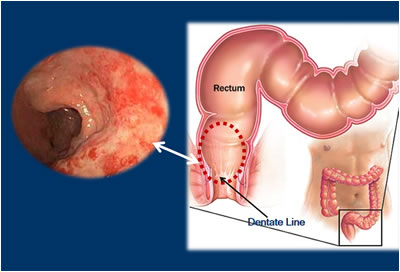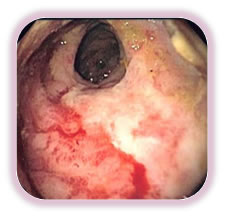Radiation Proctitis
Radiation therapy (RT) is one of the most common treatments for cancer, with nearly two-thirds of all cancer patients receiving radiation at some point during their treatment. Radiation uses high-energy particles or waves, such as x-rays, gamma rays, electron beams, or protons, to destroy or damage cancer cells. While it can be very effective at destroying cancer cells, it can lead to complications, such as Radiation Proctitis (RP).
Proctitis is an inflammation of the lining of the rectum. The rectum is a muscular tube connected to the end of the colon. The stool passes through the rectum on its way out of the body. Radiation therapy can cause chronic radiation injury that may lead to long term complications, one of which is bleeding. The rectum is involved in 90% of these patients; it is thought that the rectum's proximity to the pelvic organs undergoing treatment and its relative immobility predispose it to chronic radiation injury.
RT can cause both early (acute) and late (chronic) side effects. Acute side effects by definition occur up to 3 months after RT and are usually self-limiting. Chronic side effects occur 3–6 months after RT or even years later. Approximately 5-10% of patients receiving radiation therapy to the pelvis will develop radiation "proctopathy.” The probability of developing the injury is related to the volume of rectum irradiated, total RT dose, RT technique, and dose per fraction. Also, individual patient factors can influence the susceptibility to Chronic Radiation Proctitis (CRP): comorbidity of vascular disease, diabetes, connective tissue disease or inflammatory bowel disease, specific conditions such as smoking, and concomitant chemotherapy. The median age is about 73, with males comprising about 72% of cases. Hematochezia (passing of bright red blood in the stool) is the primary presenting symptom, and most patients (57%) are transfusion dependent. The term "proctitis" is somewhat misleading since it inaccurately implies a chronic inflammatory condition. As a result, some authorities refer to this condition as a chronic radiation "proctopathy.” However, because radiation proctitis is still used commonly, it will be used in this topic review.
Radiation proctitis involves the lower intestine, primarily the sigmoid colon and the rectum. Note the diagram and the dotted circle marking the commonly involved anatomy.

Chronic radiation proctitis has a delayed onset. The first symptoms often occur 3 to 6 months following radiation exposure but can occur at any time, with up to 30 years post-irradiation being reported. Patients may seek medical attention for one or any combination of the following symptoms:
- Bloody stools
- Diarrhea
- Urgency
- Tenesmus (painful urgent unsuccessful attempts to defecate, even when bowels are empty)
- Rectal pain
- Anal incontinence
 With more chronic RP, patients may be subjected to repeated transfusions and it is often difficult to treat medically.
With more chronic RP, patients may be subjected to repeated transfusions and it is often difficult to treat medically.CRP should be suspected in any patient who has had pelvic RT and presents with the symptoms mentioned above, even if the radiotherapy took place years ago. Diagnosis by endoscopy is important to exclude other causes of proctitis (infectious colitis, inflammatory bowel disease, diversion colitis, ischemic colitis, diverticular colitis) and a second malignancy.
After the patient presents with the sign and symptoms, endoscopy of the rectum typically shows dilated and friable mucosal blood vessels proximal to the dentate line.
Etiology (causes) Chronic radiation injury Associations Occurs in 5-10% of patients following pelvic radiation Clinical Presentation Bloody stools, diarrhea, tenesmus, urgency, rectal pain and anal incontinence Endoscopy
Inflamed mucosa, dilated and friable mucosal blood vessels; ulcer, fistula and stricture formation may be seen Complications Anemia ± transfusion-dependency Next Page: Treatments for Radiation Proctitis<
4 of 7

